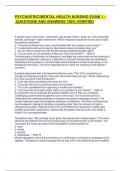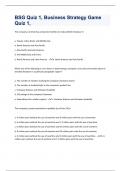PSYCHIATRIC/MENTAL HEALTH NURSING EXAM 1 –
QUESTIONS AND ANSWERS 100% VERIFIED
A patient says to the nurse, "I dreamed I was stoned. When I woke up, I felt emotionally
drained, as though I hadn't rested well." Which response should the nurse use to clarify
the patient's comment?
a. "It sounds as though you were uncomfortable with the content of your dream."
b. "I understand what you're saying. Bad dreams leave me feeling tired, too."
c. "So you feel as though you did not get enough quality sleep last night?"
d. "Can you give me an example of what you mean by 'stoned'?" - ANS: D
The technique of clarification is therapeutic and helps the nurse examine the meaning of
the patient's statement. Asking for a definition of "stoned" directly asks for clarification.
Restating that the patient is uncomfortable with the dream's content is parroting, a non-
therapeutic technique. The other responses fail to clarify the meaning of the patient's
comment.
A patient diagnosed with schizophrenia tells the nurse, "The CIA is monitoring us
through the fluorescent lights in this room. Be careful what you say." Which response by
the nurse would be most therapeutic?
a. "Let's talk about something other than the CIA."
b. "It sounds like you're concerned about your privacy."
c. "The CIA is prohibited from operating in health care facilities."
d. "You have lost touch with reality, which is a symptom of your illness." - ANS: B
It is important not to challenge the patient's beliefs, even if they are unrealistic.
Challenging undermines the patient's trust in the nurse. The nurse should try to
understand the underlying feelings or thoughts the patient's message conveys. The
correct response uses the therapeutic technique of reflection. The other comments are
non-therapeutic. Asking to talk about something other than the concern at hand is
changing the subject. Saying that the CIA is prohibited from operating in health care
facilities gives false reassurance. Stating that the patient has lost touch with reality is
truthful, but uncompassionate.
The patient says, "My marriage is just great. My spouse and I always agree." The nurse
observes the patient's foot moving continuously as the patient twirls a shirt button. The
conclusion the nurse can draw is that the patient's communication is:
a. clear.
b. mixed.
c. precise.
d. inadequate. - ANS: B
Mixed messages involve the transmission of conflicting or incongruent messages by the
speaker. The patient's verbal message that all was well in the relationship was modified
,by the nonverbal behaviors denoting anxiety. Data are not present to support the choice
of the verbal message being clear, explicit, or inadequate.
A nurse interacts with a newly hospitalized patient. Select the nurse's comment that
applies the communication technique of "offering self."
a. "I've also had traumatic life experiences. Maybe it would help if I told you about
them."
b. "Why do you think you had so much difficulty adjusting to this change in your life?"
c. "I hope you will feel better after getting accustomed to how this unit operates."
d. "I'd like to sit with you for a while to help you get comfortable talking to me." - ANS: D
"Offering self" is a technique that should be used in the orientation phase of the nurse-
patient relationship. Sitting with the patient, an example of "offering self," helps to build
trust and convey that the nurse cares about the patient. Two incorrect responses are
ineffective and non-therapeutic. The other incorrect response is therapeutic but is an
example of "offering hope."
Which technique will best communicate to a patient that the nurse is interested in
listening?
a. Restating a feeling or thought the patient has expressed.
b. Asking a direct question, such as "Did you feel angry?"
c. Making a judgment about the patient's problem.
d. Saying, "I understand what you're saying." - ANS: A
Restating allows the patient to validate the nurse's understanding of what has been
communicated. Restating is an active listening technique. Judgments should be
suspended in a nurse-patient relationship. Close-ended questions such as "Did you feel
angry?" ask for specific information rather than showing understanding. When the nurse
simply states that he or she understands the patient's words, the patient has no way of
measuring the understanding.
A patient discloses several concerns and associated feelings. If the nurse wants to seek
clarification, which comment would be appropriate?
a. "What are the common elements here?"
b. "Tell me again about your experiences."
c. "Am I correct in understanding that . . ."
d. "Tell me everything from the beginning." - ANS: C
Asking, "Am I correct in understanding that..." permits clarification to ensure that both
the nurse and patient share mutual understanding of the communication. Asking about
common elements encourages comparison rather than clarification. The remaining
responses are implied questions that suggest the nurse was not listening.
A patient tells the nurse, "I don't think I'll ever get out of here." Select the nurse's most
therapeutic response.
a. "Don't talk that way. Of course you will leave here!"
b. "Keep up the good work, and you certainly will."
c. "You don't think you're making progress?"
d. "Everyone feels that way sometimes." - ANS: C
,By asking if the patient does not believe that progress has been made, the nurse is
reflecting by putting into words what the patient is hinting. By making communication
more explicit, issues are easier to identify and resolve. The remaining options are non-
therapeutic techniques. Telling the patient not to "talk that way" is disapproving. Saying
that everyone feels that way at times minimizes feelings. Telling the patient that good
work will always result in success is falsely reassuring.
Documentation min ma mpatient's mchart mshows, m"Throughout ma m5-minute minteraction,
mpatient mfidgeted mand mtapped mleft mfoot, mperiodically mcovered mface mwith m hands, mand
mlooked munder mchair mwhile mstating, m'I menjoy mspending mtime mwith myou.'" mWhich manalysis
mis mmost maccurate?
a. mThe mpatient mis mgiving mpositive mfeedback mabout mthe mnurse's mcommunication
mtechniques.
b. mThe mnurse mis mviewing mthe mpatient's mbehavior mthrough ma mcultural mfilter.
c. mThe mpatient's mverbal mand mnonverbal mmessages mare mincongruent.
d. mThe mpatient mis mdemonstrating mpsychotic mbehaviors. m- m mANS: mC
When ma mverbal mmessage mis mnot mreinforced mwith mnonverbal mbehavior, mthe mmessage mis
mconfusing mand mincongruent. mSome mclinicians mcall mit ma m"mixed mmessage." mIt mis
minaccurate mto msay mthat mthe mpatient mis mgiving mpositive mfeedback mabout mthe mnurse's
mcommunication mtechniques. mThe mconcept mof ma mcultural mfilter mis mnot mrelevant mto mthe
msituation mbecause ma mcultural mfilter mdetermines mwhat mwe mwill mpay mattention mto mand
mwhat mwe mwill mignore. mData mare minsufficient mto mdraw mthe mconclusion mthat mthe mpatient mis
mdemonstrating mpsychotic mbehaviors.
While mtalking mwith ma mpatient mdiagnosed mwith mmajor mdepression, ma mnurse mnotices mthe
mpatient mis munable mto mmaintain meye mcontact. mThe mpatient's mchin mlowers m to mthe mchest,
mwhile mthe mpatient mlooks mat mthe mfloor. mWhich maspect mof mcommunication mhas mthe mnurse
massessed?
a. mNonverbal mcommunication m
b. mA mmessage mfilter
c. mA mcultural mbarrier
d. mSocial mskills m- m mANS: mA
Eye mcontact mand mbody mmovements mare mconsidered mnonverbal mcommunication. mThere
mare minsufficient mdata mto mdetermine mthe mlevel mof mthe mpatient's msocial mskills mor mwhether
ma mcultural mbarrier mexists.
During mthe mfirst minterview mwith ma mparent mwhose mchild mdied min ma mcar maccident, mthe
mnurse mfeels mempathic mand mreaches mout mto mtake mthe mpatient's mhand. mSelect mthe
mcorrect manalysis mof mthe mnurse's mbehavior.
a. mIt mshows mempathy mand mcompassion. mIt mwill mencourage mthe mpatient mto mcontinue mto
mexpress mfeelings.
b. mThe mgesture mis mpremature. mThe mpatient's mcultural mand mindividual minterpretation mof
mtouch mis munknown.
c. mThe mpatient mwill mperceive mthe mgesture mas mintrusive mand moverstepping mboundaries.
, d. mThe maction mis minappropriate. mPsychiatric mpatients mshould mnot mbe mtouched. m- m mANS:
mB
Touch mhas mvarious mcultural mand mindividual minterpretations. mNurses mshould mrefrain mfrom
musing mtouch muntil man massessment mcan mbe mmade mregarding mthe mway min mwhich mthe
mpatient mwill mperceive mtouch. mThe mother moptions mpresent mprematurely mdrawn
mconclusions.
During ma mone-on-one minteraction mwith mthe mnurse, ma mpatient mfrequently mlooks mnervously
mat mthe mdoor. mSelect mthe mbest mcomment mby mthe mnurse mregarding mthis mnonverbal
mcommunication.
a. m"I mnotice myou mkeep mlooking mtoward mthe mdoor."
b. m"This mis mour mtime mtogether. mNo mone mis mgoing mto minterrupt mus."
c. m"It mlooks mas mif myou mare meager mto mend mour mdiscussion mfor mtoday."
d. m"If myou mare muncomfortable min mthis mroom, mwe mcan mmove msomeplace melse." m- m mANS:
mA
Making mobservations mand mencouraging mthe mpatient mto mdescribe mperceptions mare museful
mtherapeutic mcommunication mtechniques mfor mthis msituation. mThe mother mresponses mare
massumptions mmade mby mthe mnurse.
A mblack mpatient msays mto ma mwhite mnurse, m"There's mno msense mtalking. mYou mwouldn't
munderstand mbecause myou mlive min ma mwhite mworld." mThe mnurse's mbest maction mwould mbe
mto:
a. mexplain, m"Yes, mI mdo munderstand. mEveryone mgoes mthrough mthe msame mexperiences."
b. msay, m"Please mgive man mexample mof msomething myou mthink mI mwouldn't munderstand."
c. mreassure mthe mpatient mthat mnurses minteract mwith mpeople mfrom mall mcultures.
d. mchange mthe msubject mto mone mthat mis mless memotionally mdisturbing. m- m mANS: mB
Having mthe mpatient mspeak min mspecifics mrather mthan mglobally mwill mhelp mthe mnurse
munderstand mthe mpatient's mperspective. mThis mapproach mwill mhelp mthe mnurse mengage mthe
mpatient. mReassurance mand mchanging mthe msubject mare mnot mtherapeutic mtechniques.
A mFilipino mAmerican mpatient mhad ma mnursing mdiagnosis mof msituational mlow mself-esteem
mrelated mto mpoor msocial mskills mas mevidenced mby mlack mof meye mcontact. mInterventions
mwere mused mto mraise mthe mpatient's mself-esteem, mbut mafter m3 mweeks, mthe mpatient's meye
mcontact mdid mnot mimprove. mWhat mis mthe mmost maccurate manalysis mof mthis mscenario?
a. mThe mpatient's meye mcontact mshould mhave mbeen mdirectly maddressed mby mrole-playing mto
mincrease mcomfort mwith meye mcontact.
b. mThe mnurse mshould mnot mhave mindependently membarked mon massessment, mdiagnosis,
mand mplanning mfor mthis mpatient.
c. mThe mpatient's mpoor meye mcontact mis mindicative mof manger mand mhostility mthat mwere
munaddressed.
d. mThe mnurse mshould mhave massessed mthe mpatient's mculture mbefore mmaking mthis
mdiagnosis mand mplan. m- m mANS: mD
The mamount mof meye mcontact ma mperson mengages min mis moften mculturally mdetermined. mIn
msome mcultures, meye mcontact mis mconsidered minsolent, mwhereas min mothers meye mcontact
mis mexpected. mAsian mAmericans, mincluding mpersons mfrom mthe mPhilippines, moften mprefer
mnot mto mengage min mdirect meye mcontact.





